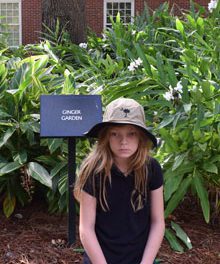 When rooms in your home need a change, you move the pictures on the wall, add a piece of furniture or lamp to give the room a new feel. We can do the same thing with outdoor garden rooms. When we add a vertical or horizontal element to the garden, it seems to change. I belong to the “garden as an illusion” school as taught by the late Emily Whaley. She believed that you create the look or focal points in the garden that you want people to see. We change the appearance of a garden room by adding something new or old. I really enjoy using old pots and buckets, crockery, and sinks as planters. They can give a timeless quality to a new garden. Antique shops, flea markets and yard sales have got some great looking planters… or things that can be used as planters. Garden designers often elevate a planter, using some kind of plant stand or pedestal. We expect to see plants in the ground, but hanging gardens were popular as far back as Babylon. One of the tricks with container gardening is to match the perfect plant with its container. This is the place where illusion and art meet. The color of the container will call attention to it. Dark shades of green, grey, and black disappear, while light bright colors stand out. Buckets and pots can be painted to look newer or older or to reinforce a color theme.
When rooms in your home need a change, you move the pictures on the wall, add a piece of furniture or lamp to give the room a new feel. We can do the same thing with outdoor garden rooms. When we add a vertical or horizontal element to the garden, it seems to change. I belong to the “garden as an illusion” school as taught by the late Emily Whaley. She believed that you create the look or focal points in the garden that you want people to see. We change the appearance of a garden room by adding something new or old. I really enjoy using old pots and buckets, crockery, and sinks as planters. They can give a timeless quality to a new garden. Antique shops, flea markets and yard sales have got some great looking planters… or things that can be used as planters. Garden designers often elevate a planter, using some kind of plant stand or pedestal. We expect to see plants in the ground, but hanging gardens were popular as far back as Babylon. One of the tricks with container gardening is to match the perfect plant with its container. This is the place where illusion and art meet. The color of the container will call attention to it. Dark shades of green, grey, and black disappear, while light bright colors stand out. Buckets and pots can be painted to look newer or older or to reinforce a color theme.
Containers either hold water or drain. Most plants need drainage, so if the container doesn’t have a hoe for drainage it will need to be drilled. On the other hand, some of them can be used as cache pots or a receptacle for another pot set down in it. Indoors, we need to protect furniture, rugs, and floors from water stains, and we can line the inside of a tub or basket with moss, plastic saucers, or foil. Remember that anything made with untreated wood, vine, or grass will begin to decompose if it’s on the ground or in contact with moisture.
Soil is important. Use good potting soil or compost for container plants. Garden dirt is often too heavy, won’t drain, and may contain harmful microbes that cause plant diseases. Some potting soils have timed released fertilizers and they are free of weed seeds. Plants in containers need to be well drained. Plants that like “wet feet” can be watered at the soil line, and keeping them in a saucer filled with water will help the roots to stay moist.
#2 Container Gardening
Fertilize blooming plants with a bloom booster (higher middle number is Phosphorus) or with a balanced (8-8-8 or 15-30-15) fertilizer. I was taught to put a little bone meal in the planting hole to give the roots a start and promote blossoms. Foliage plants, houseplants, and ferns can be fertilized using fish emulsion or a weaker mixture of quick release fertilizer. Because plants take up fertilizer nutrients from the roots, a good way to water hanging baskets and ferns is a weekly soak in a bucket or tray with 1 Tablespoon/gal fish emulsion or 1 teaspoon/gal of water soluble fertilizer. For large containers, a saucer at the base of the pot accomplishes the same thing.
Select plants to mass in containers so they will give dramatic visual impact. Plants with coarse, heavy textures can be combined with others having light airy texture. Spiky foliage can be softened using spilling and trailing plants. A tall plant in the middle or back of the planter could be an Iris, Amaryllis or spike Cordyline. For fillers you could use ferns, marigolds, zinnias, snapdragons, or just about any herbs. Spillers are going to be trialing or weeping plants like Scaveola, mints, trailing rosemary, and ferns. Be careful of ivy and vinca, because these will root wherever they touch the ground and may be invasive.
Flower color and bloom time can be anticipated. If you are having the neighbors over for an event, start planting the containers about six weeks ahead of time to have them fully grown in. Warm season and cool season annuals can give a couple of months of show. Grow herbs and vegetables close to the kitchen or grill for culinary and visual pleasure. I like to use color combinations that work together. Red and green, blue and yellow, purple and orange are complimentary colors. Monochromatic color pots just use shades of one color or maybe white with green. Remember that reds, yellows and orange shades are what we call “Hot” colors, and green, blue, and violets are going to be called “Cool” colors. Bright colors and white will seem to pop out at the viewer while dark colors will recede or move back in the landscape.
Last but really first is good sanitation. Keep pots trimmed and flowers deadheaded to keep blooms coming. Scout often for disease and insects so that problems will be found and treated early. If a plant just dies, remove it quickly so it won’t have a chance to infect others. Look for webbing or discolored leaves, isolate questionable plants, and always use clean containers, soil and healthy plants. Check out Clemson’s Home and Garden website for more information and plants that can be used for container gardening.








